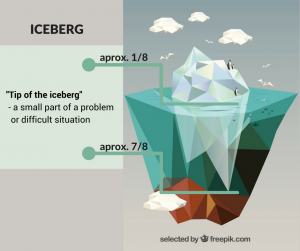Iceberg o Témpano de hielo
Un iceberg es una masa de hielo flotante que se ha desprendido de la parte frontal de un glaciar o plataforma de hielo y se ha deslizado hacia el océano (ver también: parto). Tienden a flotar durante semanas en el mar abierto hasta que se derriten.
Aproximadamente 1/8 del volumen de un iceberg está por encima de la superficie del agua.
Los icebergs se clasifican por su forma y tamaño. En general, los hay:
- Icebergs tabulares (en forma de “mesa”)
- Icebergs no tabulares (en forma de “montaña”)
La categoría de tamaño más pequeño es “growler” y la más grande (según el Centro de Navegación de la Guardia Costera de Estados Unidos) es “iceberg muy grande”, que tiene más de 75 metros de altura y más de 213 metros de largo.
Los grandes icebergs pueden representar una amenaza significativa para los barcos.
Hechos Interesantes: Los icebergs “negros” a veces ocurren. Tienen un color oscuro (debido a los sedimentos en el icebergs).
- Tabular and non-tabular icebergs (author: Dagmara Bożek-Andryszczak, Piotr Andryszczak)
- “Tip of the iceberg” (author: Dagmara Bożek-Andryszczak)




 This project (EDU-ARCTIC) has received funding from the European Union’s Horizon 2020 research and innovation programme under grant agreement No 710240. The content of the website is the sole responsibility of the Consortium and it does not represent the opinion of the European Commission, and the Commission is not responsible for any use that might be made of information contained.
This project (EDU-ARCTIC) has received funding from the European Union’s Horizon 2020 research and innovation programme under grant agreement No 710240. The content of the website is the sole responsibility of the Consortium and it does not represent the opinion of the European Commission, and the Commission is not responsible for any use that might be made of information contained.